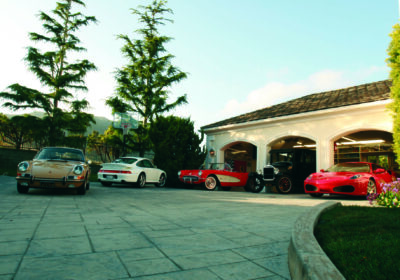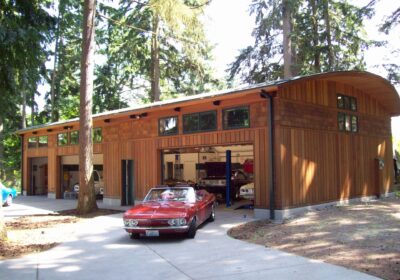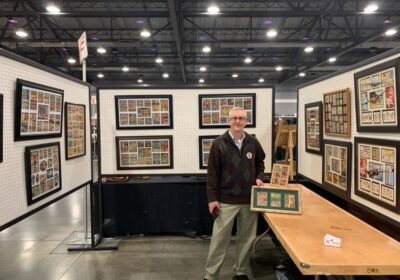Launching a business in 2020, or even thereabout, was more than a challenge. With the COVID-19 pandemic largely shutting down the world, most businesses came to a screeching halt. But, there was Phillip Griot, unknowingly opening the doors to Griot’s Motors on February 1, 2020, just a couple of months before the March shutdowns.
“We had to fight tooth and nail to get a temporary work permit by arguing we could service first responder vehicles,” he said. “It worked, we kept the business open and used the time to organize the shop.”
If Phillip’s name seems familiar, it should. He’s one of the sons of Richard Griot, founder of Griot’s Garage, a company specializing in car care products and various items to make enjoying the garage that much more fun. With Richard having retired, his other son, Nick, has taken the reigns of that company while Phillip expands the family name with Griot’s Motors, a motor vehicle restoration and sales company based near Tacoma, Washington.
“In the end, we’re all car guys, we’re all family,” said Phillip. “But Griot’s Motors is independent of Griot’s Garage. But, it’s fair to say Griot’s Garage and Richard Griot is where it all started.”
Phillip began managing Richard’s personal car collection in 2015. Working with the shop manager, he helped to discern which cars to keep, sell, buy, and restore, growing the collection and growing the scope of work. With this, space became a premium and the work multiplied, through which the idea began percolating that launching a restoration shop would be a good idea.
“We began putting out some really high-level restorations around 2016,” he said. “This was around the same time the collection was outgrowing its space. We needed a paint area, a fab area, and more tools. We also needed additional work spaces, not to mention space to keep the cars.”
With all this, Phillip began thinking about turning the concept into a full business.
“It just made sense to expand on the family name by taking our passion for high-quality restorations to the next level,” he said. “For me, that meant organizing and founding a new business.”
Phillip bought all of the restoration tools and equipment necessary to build a state of the art facility along with a new building to call home.
“It was a horrible building,” he chuckles. “But, we improved on it with fresh paint and new flooring and it began coming together.
With Covid ramping up and Richard as his only client, things were trim for a little bit. But, it wasn’t long before word got around about Phillip Griot going out on his own to open a restoration company. With this, a few other clients began trickling in to have their cars given the Griot’s special touch.
“Richard has a very high standard, a very high level of perfection on how a car should look and feel, making them as perfect as can be,” Phillip said. “This standard is what interested people in sending their cars to Griot’s Motors, it’s what we’ve built our reputation on.
“The opportunity to work with multiple customers allowed us to hire more technicians, but it was a really long process of building out the facility and training the employees,” Phillip said. “It took a lot of time to find a balance, and when you add to that the effects of a global pandemic, things were always a little rocky.”
But, building on the family’s reputation for delivering as close as possible to perfection, Phillip and his team began delivering cars. But first, he developed a process.
“We always coach people who visit, we have a restoration process, how we do things,” he said. “We begin by looking at systems holistically. A Ferrari will require a different restoration principle than a Ford. But we assess all cars while they’re together, we disassemble it, we restore each piece, but everything is done to a meticulous standard, and the process is that no detail is too small.”
In developing their restoration philosophy, they also wrote a book.
“The book is a great guide on how we want to restore vehicles,” he said. “Sometimes we need to reteach a technician on restoring cars because they come from another shop and we need them to learn and adhere to our ways. It’s not that they don’t have their own valuable experiences and skills, we build on those as well. But they must also respect how this shop expects things to be done.”
Sometimes too, customers need to be taught the Griot method. In approaching a restoration, Griot’s Motors uses the Triage Analysis, which is generally applied in the medical and military fields for assessing patients and their needs. But Griot’s has found that they can apply it to the restoration business as well.
“Essentially, the Triage Analysis allows us to prioritize what needs to be done most urgently down to the least important item,” said Phillip. “This allows us to organize what tasks should be accomplished first, and it often varies from car to car. One car might desperately need corrosion abatement while another needs mechanical rebuilding. While this gives us a road map to plan out a restoration, it also allows us to more closely figure out costs and a budget.”
To begin the process, usually potential clients visit the shop so that the company can demonstrate what they do, what the customer can anticipate from a Griot restoration, and learn the expectations of the customer. Furthering this discovery period, Phillip says it’s extremely important to learn the customer’s goals.
“What do they want to do with the car? It’s very important to have a clear understanding here, because some customers are simply looking to get the car to a better level and put it on the market. But we also have customers who are emotionally attached to the car, and want it made right, even if the costs involved are worth more than the car itself.”
Learning what the customer wants allows Griot’s to figure out what it’s going to cost to get it there.
“We generally don’t like doing flip work,” he said. “Frankly, our work is too important to us and the costs are too high. We’re not cheap, but we want customers to enjoy their cars. The only way to ensure that is to restore the car right, and that isn’t always easy.

“Cars are made up of a multitude of components. More often than not, the customers never see those parts, because they’re buried within the car, and because of that, they can’t understand paying for their individual restorations. Maybe it doesn’t matter to them, but to us, it does. Each piece of any machine is dependent on another and likely then another. It’s holistic, all inclusive. The systems all work together. We need to ensure every piece is working perfectly. Clients sometimes don’t like that idea, they feel it’s maybe too ‘over-the-top’ for them, and we both need to admit when a project might not be a good fit.
“We’ll organize a how to make this car its best without breaking the bank,” Phillip said. “Our clients love us because we treat the cars like they’re our own. It’s important to us, it’s not just another car or a job. It’s so much more. This is why, really, our best customers are emotionally attached to the car. It’s not because they’ll spend more money, it’s because they want to see the best end result possible. We are delivering people’s dreams. It’s important to nail that, and it’s the last 10 percent of a restoration to make sure it’s spot on. We will put 200 to 500 miles on a car to make sure it’s absolutely correct. We want to make sure it’s right and ready for you to enjoy the car on a well-deserved weekend after a long week of work.”
Learn more about Griot’s Motors




































